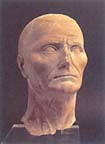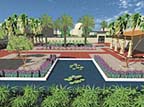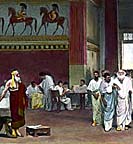
"From the earliest days of the city, the hub of Roman business, politics, and ceremony had been the Forum Romanum. Located at the base of the Palatine hill just south of the capital, the Forum Romanum was embellished over the years with temples, places of meeting and business, and various honours to famous citizens. Here, politicians debated, citizens met, talked, and voted, priests made sacrifices, and triumphant generals rode through on their way to the Capitol. On special occasions, gladiators even fought to the death while spectators looked on from temporary wooden stands. By the time of Caesar, however, the old forum was no longer large enough to handle all the business which needed to be transacted. Some of these activities were moved elsewhere: for example, new facilities for voting were constructed on the Campus Martius, removing a major political function of the old Forum. The other approach to this problem of space was to construct supplementary venues nearby. Caesar, Augustus, and Nerva each built new fora to the north east of the old Forum, but still linked to it and to each other by doors and passageways. Domitian is said to have started construction on a fourth imperial forum, but work on this ceased at his death. Thus, it was left to Trajan to fill the need for yet more forum space. Trajan did more, however, than simply provide more space for the public business of Rome; he constructed at the same time a monument to himself and to the glory of the Empire.
The two main elements of the new Forum of Trajan were an open piazza and a basilica, and both were astonishingly large. The entire Forum of Nerva would have fit within the basilica, and the piazza, its open area alone measuring more than 80m in width and 120m in length, was large enough to hold almost the entire Forum of Augustus. This piazza, the heart of the Forum, was paved with imported marbles and surrounded by a colonnade. Atop this colonnade were inscriptions stating that the whole complex had been built using the spoils of war taken by the emperor. One of the functions of this massive open space was to provide a setting for public business and ceremony. For example, the successor of Trajan, Hadrian, performed in it a great ceremony of burning debt records. Later, during a time of dire military need, the emperor Marcus Aurelius used it as a venue for a great auction of the imperial possessions. Another function was to provide a display area in which to exhibit honours to great Romans. Naturally, the greatest honour went to Trajan himself, who was immortalised by a great equestrian statue, cast in bronze, gilded, and placed atop a pedestal in the centre of the piazza. The size of this statue was so great that it defied replication by any later rulers. When the emperor Constantius visited the Forum of Trajan in the 4th century, he declared somewhat rashly that he would order a copy of this horse to be made. One of his companions, a Persian prince named Ormisda, replied wittily that first the emperor should build a new stable, if he could, so that the proposed new steed might roam as freely as the one they saw before them. The base of this statue has recently been discovered in the centre of the Forum piazza, and its measurements give us an idea of the size of the horse which Constantius desired to copy: the horse and rider together (not including the base) may have been as much as 12 metres tall. By comparison, the famous equestrian statue of Marcus Aurelius, which now stands on the Capitol, is only about one third as large.
Beyond the eastern end of the piazza was a multi-level market, in which spices and other luxuries were sold. The solid brickwork of this structure has proven so enduring that, except for the column, it is today the best preserved element of the forum complex. The north end of the piazza was dominated by the basilica. Its huge interior space (120m by 55m) was covered by a timber and tile roof supported on a forest of massive columns, and was enlarged by the provision of apses at each end. Its decoration was sumptuous. The walls and floor were clad in marble, and the roof was covered with bronze tiles thickly gilded. This sheltered yet extremely imposing space would have provided a suitable setting for public business, especially important trials. The dual apses, unusual for a Roman basilica, may have been added to double the space available for such affairs.
When finally sated with the sights of the grand piazza, exhausted by the bustle of the market, and overwhelmed by the fervent pleading of the advocates in the basilica, a visitor could exit the north side of the basilica and enter a much different environment. Walking out through the last row of imposing columns, our visitor would emerge into a small courtyard on the other side of the basilica. This courtyard was flanked to the west and east by two libraries, one for Latin and one for Greek texts. It is not certain what lay to the north. A temple to the divine Trajan has been suggested, but no remains of such a building have been found in this area. However, a visitora's attention would be immediately drawn to the imposing monument which stood in the centre of the court: the column of Trajan."
 "A new exhibit at the National Museum of Western Art in Tokyo features Roman funerary sculpture gleaned from the collection of the Vatican Museum. The tradition of funerary portraiture grew out of elite practices during the years predating Augustus' epochal Pax Romana, the era of (relative) peace brought about by Roman domination of the Mediterranean region. In those early years -- the literary heyday of Rome (the first century B.C. produced Virgil, Horace, Ovid and Livy) -- wax portraits known as imagines would be paraded in the funeral processions of the upper classes. These would then be displayed, perhaps alongside portraits or busts in bronze, marble or terracotta, in the lararium (household shrine), not unlike the way photographs of ancestors are displayed to this day on the butsudan (family altar) in many Japanese homes.
"A new exhibit at the National Museum of Western Art in Tokyo features Roman funerary sculpture gleaned from the collection of the Vatican Museum. The tradition of funerary portraiture grew out of elite practices during the years predating Augustus' epochal Pax Romana, the era of (relative) peace brought about by Roman domination of the Mediterranean region. In those early years -- the literary heyday of Rome (the first century B.C. produced Virgil, Horace, Ovid and Livy) -- wax portraits known as imagines would be paraded in the funeral processions of the upper classes. These would then be displayed, perhaps alongside portraits or busts in bronze, marble or terracotta, in the lararium (household shrine), not unlike the way photographs of ancestors are displayed to this day on the butsudan (family altar) in many Japanese homes.
 "Closed for six years, the planetarium at the Rosicrucian Egyptian Museum has reopened with a show on the skies of 2020 B.C., the cusp of a celestial shift that spawned one of the major competitors of early Christianity.
"Closed for six years, the planetarium at the Rosicrucian Egyptian Museum has reopened with a show on the skies of 2020 B.C., the cusp of a celestial shift that spawned one of the major competitors of early Christianity.
 "A landmark exhibition featuring three centuries of Byzantine culture opens tomorrow at the Metropolitan Museum of Art in New York. Seven years of research, negotiations, and collaboration have brought together 377 artifacts from 27 countries -- among them Russia, Bulgaria, Serbia and Montenegro, Romania, Macedonia, Egypt, Greece, and Turkey. Many of the masterpieces are borrowed from churches and monasteries, and have never been exhibited before.
"A landmark exhibition featuring three centuries of Byzantine culture opens tomorrow at the Metropolitan Museum of Art in New York. Seven years of research, negotiations, and collaboration have brought together 377 artifacts from 27 countries -- among them Russia, Bulgaria, Serbia and Montenegro, Romania, Macedonia, Egypt, Greece, and Turkey. Many of the masterpieces are borrowed from churches and monasteries, and have never been exhibited before.
 "If multi-media mythology sounds appealing, simply strap on a pair of Winged Sandals. As those who still remember their Greek mythology will know, the site's title refers to the unique footwear of Hermes, messenger of the gods (and more recently, upscale clothing and accessories retailer). The artist's interpretation of the immortal emissary, and the messenger's 'Alvin and the Chipmunks' voice make it clear at the outset that this is a site primarily designed to introduce children to its subject matter. (The target age is 6-12 years old.) But while the information is appropriately rudimentary, interested adults can still get a quick refresher course, and won't be bored while supervising their children's visits. (The Australian Broadcasting Corporation production won best e-learning site and best in show at the annual Australian Interactive Media Association awards in February.)
"If multi-media mythology sounds appealing, simply strap on a pair of Winged Sandals. As those who still remember their Greek mythology will know, the site's title refers to the unique footwear of Hermes, messenger of the gods (and more recently, upscale clothing and accessories retailer). The artist's interpretation of the immortal emissary, and the messenger's 'Alvin and the Chipmunks' voice make it clear at the outset that this is a site primarily designed to introduce children to its subject matter. (The target age is 6-12 years old.) But while the information is appropriately rudimentary, interested adults can still get a quick refresher course, and won't be bored while supervising their children's visits. (The Australian Broadcasting Corporation production won best e-learning site and best in show at the annual Australian Interactive Media Association awards in February.)
 "The Latin alphabet derived from the Etruscan, which was adopted from the Greek of colonists who had settled at Cumae in Campania. An indication of this borrowing is that the sound of k was conveyed by three different letters: gamma (G) before e and i, kappa (K) before a, and koppa (Q) before u. (Indeed, that is their names: ce, ka, qu). In Latin, kappa soon became redundant, except in the archaic spelling of such words as Kalendae (the first day of the Roman month), and was dropped from the alphabet. And Q was restricted to cases in which it preceded u. Principally, it was gamma, the third letter in the Greek alphabet and represented by the letter C in Latin, that conveyed the sound of k.
"The Latin alphabet derived from the Etruscan, which was adopted from the Greek of colonists who had settled at Cumae in Campania. An indication of this borrowing is that the sound of k was conveyed by three different letters: gamma (G) before e and i, kappa (K) before a, and koppa (Q) before u. (Indeed, that is their names: ce, ka, qu). In Latin, kappa soon became redundant, except in the archaic spelling of such words as Kalendae (the first day of the Roman month), and was dropped from the alphabet. And Q was restricted to cases in which it preceded u. Principally, it was gamma, the third letter in the Greek alphabet and represented by the letter C in Latin, that conveyed the sound of k.
 By Paul Zanker
By Paul Zanker
 "From the earliest days of the city, the hub of Roman business, politics, and ceremony had been the Forum Romanum. Located at the base of the Palatine hill just south of the capital, the Forum Romanum was embellished over the years with temples, places of meeting and business, and various honours to famous citizens. Here, politicians debated, citizens met, talked, and voted, priests made sacrifices, and triumphant generals rode through on their way to the Capitol. On special occasions, gladiators even fought to the death while spectators looked on from temporary wooden stands. By the time of Caesar, however, the old forum was no longer large enough to handle all the business which needed to be transacted. Some of these activities were moved elsewhere: for example, new facilities for voting were constructed on the Campus Martius, removing a major political function of the old Forum. The other approach to this problem of space was to construct supplementary venues nearby. Caesar, Augustus, and Nerva each built new fora to the north east of the old Forum, but still linked to it and to each other by doors and passageways. Domitian is said to have started construction on a fourth imperial forum, but work on this ceased at his death. Thus, it was left to Trajan to fill the need for yet more forum space. Trajan did more, however, than simply provide more space for the public business of Rome; he constructed at the same time a monument to himself and to the glory of the Empire.
"From the earliest days of the city, the hub of Roman business, politics, and ceremony had been the Forum Romanum. Located at the base of the Palatine hill just south of the capital, the Forum Romanum was embellished over the years with temples, places of meeting and business, and various honours to famous citizens. Here, politicians debated, citizens met, talked, and voted, priests made sacrifices, and triumphant generals rode through on their way to the Capitol. On special occasions, gladiators even fought to the death while spectators looked on from temporary wooden stands. By the time of Caesar, however, the old forum was no longer large enough to handle all the business which needed to be transacted. Some of these activities were moved elsewhere: for example, new facilities for voting were constructed on the Campus Martius, removing a major political function of the old Forum. The other approach to this problem of space was to construct supplementary venues nearby. Caesar, Augustus, and Nerva each built new fora to the north east of the old Forum, but still linked to it and to each other by doors and passageways. Domitian is said to have started construction on a fourth imperial forum, but work on this ceased at his death. Thus, it was left to Trajan to fill the need for yet more forum space. Trajan did more, however, than simply provide more space for the public business of Rome; he constructed at the same time a monument to himself and to the glory of the Empire.